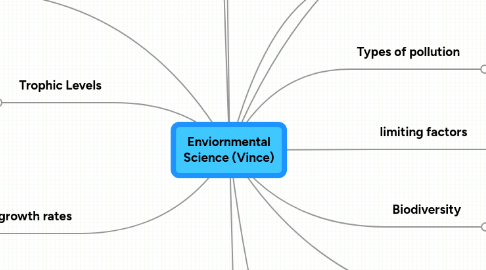Enviornmental Science (Vince)
by vince ball

1. Biomes
1.1. Rain Forest
1.2. Temperate deciduous forest
1.3. Coniferous forest
1.4. desert
1.5. Tundra
1.6. Freshwater biome
1.7. Marine biome
1.8. Grassland/savanna
2. Trophic Levels
2.1. Producer
2.2. Primary Consumer
2.3. Secondary Consumer
2.4. Tertiary Consumer
2.5. Decomposers
3. Populations
3.1. endangered species have little numbers left and are at risk for extinction
3.2. Threatened species are like endangerd species but have a few more numbers
3.3. hot spots are areas that contain alot of different species
3.4. indicator species are species that need a specific envirment to survive and therefor can tell you things about the envirment
3.5. population growth is how much a population grows in a certain amount of time
3.6. Population growth rate is how fast a population grows in a certian amount of time
4. growth rates
4.1. Exponential growth is a rate that continues to increase at a faster and faster rate
4.2. J- curve is a growth rate the starts of slow but then increases rapidly
4.3. S-curve is a growth rate similar to the J-curve except it slows down towards the farther you go
5. Water Terms
5.1. Aquifer is an underground pocket of water that supplies people with wells
5.2. Desalination is the removal of salt from salt water
5.3. water pollution is when foreign materials enter water supplies
5.4. water purification is when you remove materials from the water through filtering or other methods
5.5. Water shed is an area where all the water from the region drains, one way or another, into a basin or a river
5.6. Wetlands are areas of land that contain high amounts of water
5.7. Runoff is when water flows over surfaces and takes materials with it
6. Water pollution terms
6.1. Erosion is when water runoff take soil and dirt with it eventually ending up in a lake or stream
6.2. Impermeable means that water can not be obsorbed by it, this means that there is high runoff on impermeable surfaces
6.3. Urbanization is the development of domestic homes and buildings to a forested area
6.4. Point source pollution is pollution that is easly identifiable and therefore easlity tested
6.5. Non-point source pollution is pollution that comes from many sources and is hard to identify
7. Levels of Organization Smallest to Biggest
7.1. organism
7.2. population
7.3. community
7.4. ecosystem
7.5. Biome
8. Biodiversity
8.1. Genetic Biodiversity
8.2. Species Biodiversity
8.3. Ecosystem Biodiversity
8.4. Threatened species
9. limiting factors
9.1. biotic like amount of the certain species or compitition
9.2. abiotic like amount of soil or sediment
9.3. carrying capacity (how big of a population can that envirment handle)
10. mapping
10.1. Food chain maps out one thing the consumes the next thing in order
10.2. Food web is a map that shows lots of thing the draw energy from many thing in no order
11. Ecological succession
11.1. Pioneer species
11.2. primary succession
11.3. secondary succesion
11.4. climax community
12. Types of pollution
12.1. Organic pollutants are pollutants that aren't manufactured like soil, waste, and leaves
12.2. Inorganic pollutants are pollutants that are manufactured like plastic, glass, and garbage
13. Reasources
13.1. Natural reasources are materials that come from the earth, most materials are natural in some way
13.2. Renewable resources are materials or power supplies that can be replaced within the span of a human life
13.3. Nonrenewable resources are materials or power supplies that can not be replaced withing the span of a human life


